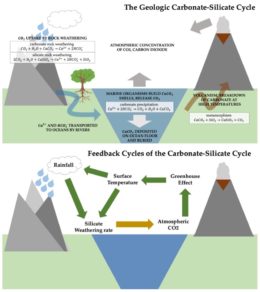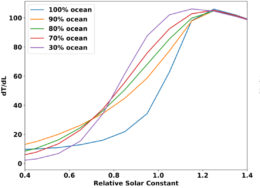A critical component of a habitable planet is its ability to stabilize its climate over long timescales. In a new study, scientists explore whether a world covered in water can keep its climate as stable as an Earth-like, continental world.
The Carbon Goes Round and Round

Diagram of the physical and chemical processes (top panel) and feedback loops (bottom panel) associated with the carbonate–silicate cycle. Click to enlarge. [Gretashum]
So how do you keep a climate stable against these slow shifts? One crucial factor is having a carbonate–silicate cycle. This cycle dictates how carbon is moved around a planet, sometimes burying it deep below the planet’s surface, sometimes releasing it out into the atmosphere.
On Earth, a simplified description of the carbonate–silicate cycle is:
- Atmospheric carbon dioxide dissolves in rainwater, forming carbonic acid, which falls to the ground.
- Over long timescales, weathering from this weak acid dissolves silicate rocks, and the dissolved products are carried to the oceans, where they accumulate.
- Subduction of the seafloor carries the products to great depths, where they reform into silicates and gaseous carbon dioxide.
- The carbon dioxide is restored to the atmosphere by volcanism.
When Negative Feedback Is a Good Thing
In an ideal scenario, the carbonate-silicate cycle acts as a planet’s thermostat, with negative feedback loops keeping the temperature of the planet in balance. If oceans freeze over, silicate weathering slows, causing atmospheric carbon dioxide to accumulate and warm the planet via the greenhouse effect. If the planet heats, rainfall increases and silicate weathering speeds up, removing carbon from the atmosphere and cooling the planet.

Illustration of a water world around a cool, dim star. The ability of a planet to stabilize its temperature as its host star evolves is important to habitability. [M. Kornmesser/Hubble/ESA]
In a new study, scientists Benjamin Hayworth and Bradford Foley (Pennsylvania State University) consider how this cycle might be affected by the geography of a planet. Will worlds covered in water do a better or worse job of keeping their climates stable?
Stability from the Sea

Climate buffering capacity of planets with varied ocean coverage, for changes in stellar luminosity. Colored curves correspond to different fractional ocean coverage. Lower values of dT/dL, the change in surface temperature with luminosity, mean the planet is better at stabilizing its climate. [Adapted from Hayworth & Foley 2020]
By accounting for these different dependencies in climate and weathering models, the authors show that water worlds — which are dominated by seafloor weathering — are actually better than their continental counterparts at stabilizing planet-wide temperatures against gradual changes in host star luminosity.
This means that temperate climates can exist over a wider range of stellar luminosities for water worlds than for continental planets, and they can stay stable for longer — indicating that these worlds may be worthwhile targets in the search for life.
Citation
“Waterworlds May Have Better Climate Buffering Capacities than Their Continental Counterparts,” Benjamin P. C. Hayworth and Bradford J. Foley 2020 ApJL 902 L10. doi:10.3847/2041-8213/abb882

1 Comment
Pingback: From AAS NOVA: “Climate Stabilization on Distant Worlds” | sciencesprings